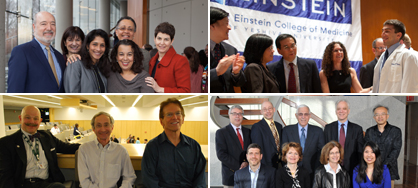

The Bias of Doctors
Change of Mind, Change of Health
Can asking uncomfortable questions reduce health disparities? Recent studies have found that than their counterparts in other developed countries, and that racial and ethnic minority groups are particularly affected by persistent disparities in healthcare access and quality. But physicians who are willing to take an extra moment to question their patients—and themselves—could provide better care and help narrow the healthcare gap.

AIrene Blanco, M.D.Dr. Irene Blanco recalled one morning being on rounds with a rheumatology fellow when she attempted to evaluate a patient who was severely disabled by rheumatoid arthritis. "We literally walked into his room together and walked right out," she said. "But when I asked [the fellow] why the patient smelled so bad, she couldn't give me an answer."
Further discussion with the patient revealed that he was an undocumented immigrant, out of work and unable to afford medication to manage his debilitating condition (nearly $60 a month at the CVS pharmacy). His limited mobility made everyday activities such as bathing nearly impossible.
"Nobody had ever told him that he could get his medication for $3 a month from the Montefiore pharmacy," said Dr. Blanco, an Einstein and Montefiore rheumatologist who studies healthcare disparities affecting patients with lupus, osteoarthritis, and rheumatoid arthritis.
Physicians' perceptions of their patients can lead to uneven evaluations and different treatment recommendations, and these perceptions may be affected by patients' race and socioeconomic status. According to Dr. Cristina Gonzalez, a hospitalist at Montefiore and associate director of the Institute of Community and Collaborative Health at Einstein, presumably unintentional—and often unrecognized—biases can adversely affect the quality of care that physicians provide to their patients, particularly minorities.
"Unintentional, 'implicit' biases reside in the subconscious and are a natural result of acculturation and life experience," said Dr. Gonzalez. "But when wrong assumptions are made about a patient, they can lead to clinical decisions that are detrimental to a patient's health and well-being."
When Race "Colors" Care
Dr. Gonzalez, whose research focuses on health disparities education with emphasis on implicit bias recognition and management, cited numerous studies demonstrating race-based healthcare differences, including findings that physicians were less likely to initiate HIV therapy for black male patients or prescribe thrombolysis to black patients with chest pain. Additionally, physicians' communication style worsened with black patients, or if the physician perceived patients' communication skills to be limited.
It is not thought that explicit (conscious) bias, which would be considered racism, is at the root of these differences, according to Dr. Gonzalez. "The overwhelming majority of physicians would be appalled to discover they may be unintentionally hurting some patients," she said. "Finding safe ways to discuss implicit biases, and to bring the issue into a physician's conscious awareness, can positively enhance medical decision-making and patient-centered care."

Cristina Gonzalez, M.D. Racial differences may also hinder physician-patient communication about the cost of medication. Dr. Blanco recalled a study of recorded office visits between rheumatologists and patients, which found that the topic of the pricing of medication arose more often in conversations between white patients and white providers. "This is a main social determinant of care, and I don't think asking whether they can afford their medication and helping them figure out how to get it is any kind of taboo at all," Dr. Blanco said. "While it's not clear why this happens, providers need to be trained to help address these key issues."
Improving physicians' self-awareness of their own biases could lead to better care and reduced disparities. In an exercise she uses when teaching medical students, Dr. Gonzalez integrates the Implicit Association Test (IAT), an online instrument believed to measure implicit attitudes such as perception and stereotypes. Students' results from this test provide a basis for reflective narrative writing and group-based reflection. Dr. Gonzalez's efforts have resulted in more medical students reporting that implicit biases affect them, and demonstrating improved attitudes in response to challenging, bias-eliciting role-plays.
"Enhancing the safety of the discussions and normalizing the topic has made students more receptive to the idea that while they have implicit bias, this does not mean they are racist. It has opened the door to honest discussion and increased their reception to strategizing and sharing their reactions as patient and provider in role-plays," Dr. Gonzalez said.
Dr. Blanco advocates raising physicians' awareness of the communities surrounding their practices. "I knew that we had a poor population in the Bronx, but I didn't know how poor, or how low the education level was until I started actually looking at the statistics," she said. "The more we can address these disparities in our own individual populations, the better our patients are going to do in the end."
Start With a Question
Dr. Gonzalez recommends that physicians start by taking the IAT themselves, reflecting on their results or discussing them with a trusted friend or colleague. "We often call on our colleagues to discuss a clinical case or teaching challenge. Why not discuss encounters in which implicit bias may play a factor?" she said.
She also recommends the following interventions to enhance physician-patient communication:
- Recognizing when patient encounters feels uncomfortable
- Determining when assumptions made about patients are hindering communication
- Approaching questions from a patient-centered perspective
- Asking the patient what they are most worried about or how they best want to be helped
- Devising honest statements to apologize when an assumption is verbalized and proven to be incorrect
"These simple steps can help physicians provide all of their patients with equitable, exceptional care," said Dr. Gonzalez.
When physicians take an extra moment to gather information to help a patient, striking improvements can result. Dr. Blanco and the fellow's discussion with their patient revealed that he was able to afford the $3 a month to get his medication from the Montefiore pharmacy. His rheumatoid arthritis was effectively managed with a moderate dose of methotrexate, he is able to bathe and care for himself, and is now back in the community with a part-time job. "The smallest intervention—like simply asking ourselves what is creating such a mess, and what resources are available to fix it—can really change a person's life," said Dr. Blanco.
Posted on: Friday, May 24, 2013


